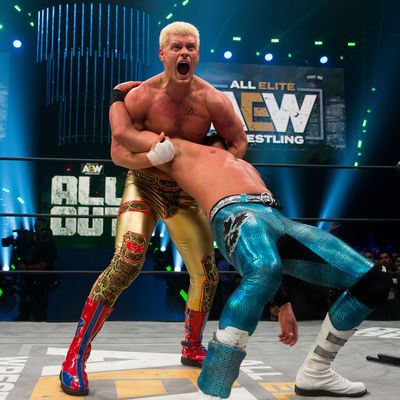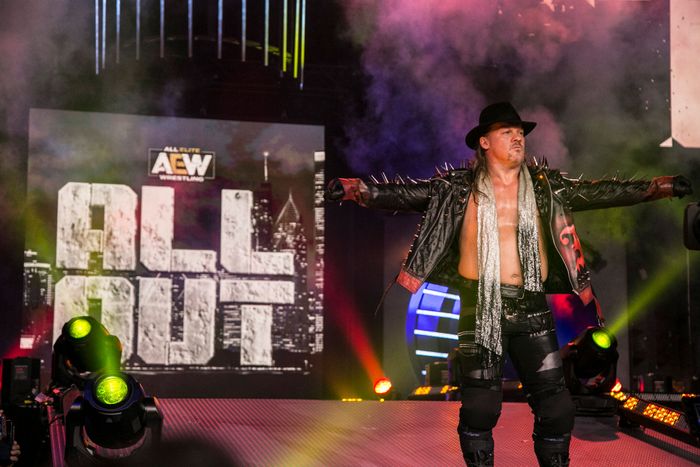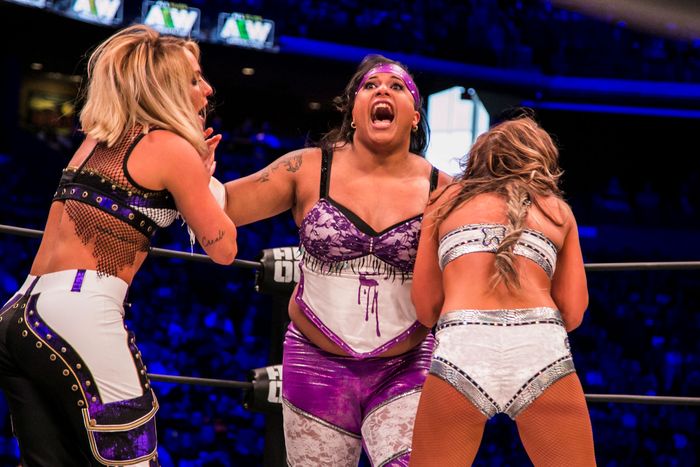
It’s mid-September, and Rafael Morffi and his team still have two weeks to do the seemingly impossible: launch a live, weekly, nationally broadcast two-hour wrestling show in prime time, for a major cable network. It’s something no company has endeavored to do since Ted Turner’s now-defunct World Championship Wrestling premiered its Monday-night Nitro program on TNT in September 1995.
As it happens, Morffi’s in-progress production has a home on TNT as well. It’s called AEW Dynamite, and debuts October 2 at 8 p.m., live from Washington, D.C.’s Capital One Arena. (The show will broadcast from different cities each week.) AEW stands for All Elite Wrestling, the buzziest and most audacious promotion to put its hat in the ring in at least a generation. Morffi, who has worked for Vince McMahon’s World Wrestling Entertainment, as well as perennial upstart rival Impact Wrestling, is AEW’s live-events director. At the time of our conversation, he’s about halfway through his fourth month on the job, which makes him a relatively senior staffer.
“We know we have a challenge in front of us,” Morffi says, understating the matter. “We’re moving fast and furious. We’re ready.”
That goes twofold for wrestling fans, who for two decades have had few televised alternatives outside routine WWE programming, anchored by USA stalwart Monday Night Raw and the more mobile SmackDown, which has bounced around the schedule and shifts to Fox on Fridays beginning October 4. But while WWE has been preoccupied with expanding its global footprint, and adding subscribers to its fledgling streaming network since acquiring WCW in 2001, an independent wrestling culture has flourished, ironically reminiscent of the sprawling territorial patchwork synonymous with the sport before McMahon and WWE barnstormed the business in the 1980s.
By the turn of the 2010s, Impact (originally branded as TNA) surfaced on Spike, one of its several landing spots, and grassroots promotions such as Philadelphia-rooted Ring of Honor found their way onto the cable guide’s outer margins. Today, a modest cluster of competitive outfits — and enterprising TV executives — has seized on the sport’s renewed, cultish buzz. New York-based Major League Wrestling airs its Fusion series every Saturday night on beIN Sports, while the Mark Cuban-founded and Anthem-owned AXS TV airs Impact Tuesday nights and New Japan Pro Wrestling and WOW-Women Of Wrestling Saturday nights.
“The overall atmosphere of pro wrestling is very similar now to what it was in 1995,” observes Bryan Alvarez, co-host of popular podcast Wrestling Observer Live, co-author of The Death of WCW, and author of 100 Things WWE Fans Should Know & Do Before They Die. “In 2010, WWE was a lot stronger in a lot of ways than they are now. They had way more viewers. The level of disgruntlement among fans today is much higher. People were not as hungry for an alternative then as they are now.”
On cue, along came the cohort of Cody Rhodes, the Young Bucks (brothers Matt and Nick Jackson), Kenny Omega, Marty Scurll, and “Hangman” Adam Page. Collectively, they dubbed themselves The Elite, complete with a YouTube series titled Being the Elite that boasts close to 400,000 subscribers and formally declared AEW’s formation via a viral New Year’s Day video.
Rhodes, son of late legend Dusty and brother of active fan favorite and AEW signee Dustin (long known as Goldust in WWE), left WWE in 2016 and made waves in Ring of Honor and New Japan. It was on that sojourn that he struck an alliance with the other Elite members, who’d been top-billed guys for some time in those same organizations. A brainstorming session led to a hugely successful, independently produced live event, All In, which sold out the 10,000-plus capacity Sears Centre in suburban Chicago last September and led them to billionaire Jacksonville Jaguars co-owner Tony Khan (his father, Shahid, is principal Jaguars owner), an avowed wrestling nut with cash to spare. (Unsubstantiated reports have suggested the Khans made an up-front investment of $100 million in AEW. When asked for clarification, AEW reps responded that they do not disclose financial information.)
By fall 2018, the groundwork for AEW was laid, followed by months of personnel tweaks (Scurll stayed on with Ring of Honor), crunching numbers, and careful hiring (veteran play-by-play man Jim Ross as commentary lead and backstage consultant, former WWE World Champion Jon Moxley as a marquee main-eventer). By late summer ’19, the company had pulled off two well-regarded pay-per-view events — May’s Double or Nothing in Las Vegas and August’s All Out, an ostensible sequel to All In that sold out in 15 minutes — partnered with Bleacher Report’s streaming service, B/R Live, for a pair of exhibition-like free specials, and crowned its first-ever world champion, ex-WWE/WCW icon Chris Jericho. All of it was preparation for Dynamite’s October 2 bow.
“We were fortunate to have that summer run,” Morffi concedes. “That helped us iron out everything and get the kinks out, while still getting our brand out there in a tangible format.”
AEW’s shotgun approach is effectively an inversion of how a promotion typically evolves — from broadcast to PPV, not the other way around — and it’s reflective of Khan’s top-down emphasis on analytics, an extension of his approach to the Jaguars (not to mention soccer club Fulham FC, which he co-owns as well) and TruMediaSports, his analytics-driven engineering firm.
“Part of the reason why we did two shows on B/R Live was to harvest data,” confirms Morffi. “We offered it for free purposely to expose the product and collect that information, to know where our fanbase is coming from initially.”
Judging by the names and faces who’ve been front and center on Dynamite marketing materials, fans are looking for characters like towering MMA expert Luchasaurus (whose tag partner, Jungle Boy, is the late Luke Perry’s son, Jack) and openly transgender woman Nyla Rose as much as they’re banking on the star power of company figureheads like co-executive vice presidents Cody Rhodes and Omega. Beyond that, it remains to be seen how Dynamite might pare down the B/R Live events’ open-audition atmosphere into a precision combat-sport and storytelling machine.
Therein lies the most pressing question for TNT and Dynamite, and above all wrestling fans and potential converts: Will all the beta testing and sunk costs translate into an awesome and inspiring two hours of TV every Wednesday? If it can’t satisfy that initial threshold, any discussion about whether AEW can ultimately share the air with WWE — which cannily resituated its streaming network’s NXT program, a showcase for developing talent, to USA directly opposite Dynamite — will feel premature at best. (Neither WWE nor Fox made anyone available for comment as of press time.)
AEW World Champion Jericho was part of both Nitro and SmackDown’s earliest days, so he knows a thing or two about how WWE operates. Yet, in a phone interview just eight days prior to Dynamite’s inaugural effort, he betrays no worries about McMahon’s maneuvering. Nor, for that matter, is he sweating any outside skepticism about whether AEW can distinguish itself.
“We’ve assembled this amazing roster with six to eight top main-event stars, which is what you need to start a wrestling company,” Jericho outlines, adding that the financial backing and TV deal are, without a doubt, equally instrumental. But AEW’s status as an industry disrupter also hooks onto a narrative with baked-in appeal for today’s super-attentive pop-culture polyglots, regardless of how steeped they are in wrestling lore.
As Jericho pointedly notes, “This is the first time ever in the history of wrestling that fans can be with a major company from the start … It’s a new-age promotion where I can go, ‘These are my guys, and I want to grow with them.’ You can see all this loyalty we have from fans who aren’t even watching WWE programming. They’re not watching WrestleMania, but they’re watching All In.”
The fact that AEW’s leadership had already gathered metrics to back up Jericho’s assertion, not to mention having sold out arenas like Las Vegas’s MGM Grand, was plenty to grease the wheels with TNT. (Khan’s deep pockets and devotion to the product didn’t hurt, either.) And from the get-go, AEW was keenly aware that for Dynamite to succeed on its own merits — not purely in terms of whether it can pull some of WWE’s market share — the packaging and presentation had to lean into the show as sport, not spectacle. (WWE had long since messaged its content as “sports entertainment.”)
That calculus neatly coincided with the owner-wrestlers’ central philosophy about their trade. AEW chief brand officer Brandi Rhodes, who also performs in the women’s division and frequently accompanies her husband Cody to the ring, underscores that point when she reminds everyone that from AEW’s onset, she and her colleagues have “been very honest about feeling like the bell-to-bell action needs to be well represented in wrestling, so that’s what we’re making our main focus.” Rhodes, speaking a week and a half before Dynamite’s unveiling, expresses appreciation for WWE and others’ heightened theatrics, but is firm that with Dynamite, “You’re probably going to see everything happen inside the arena. You’re probably not going to see a lot of things backstage. Everything is directed toward the sports end of the show.”
That suits the suits at TNT just fine. The network has an established reputation broadcasting the NBA and NCAA, as two examples, and sees Dynamite as a natural fit in that rubric as opposed to a novelty outlier.
“Live television is still the king of the castle,” asserts Brett Weitz, general manager of TNT, TBS, and TruTV. “And what we looked at [with Dynamite] was a live sporting event that we felt was serving an underserved marketplace.” Referencing the public perception of WWE’s ubiquity, Weitz adds that, “When you just have a monopoly for 20 years, you don’t know who’s out there in the wings waiting for something different. … I will bet there is a very different audience in the AEW audience that is hopefully migrating to this network because of this offering.”
If Weitz is right, it could paradoxically forecast doom for the MLWs and Impacts of the world, which are at varying stages in their life cycles but conjoined in their struggle to stay relevant and grow viewership. If Dynamite soars, the benefits could trickle down — or AEW could become an unwitting accomplice to a duopoly alongside WWE. It’d be nice to think that there’s enough talent and time and innovation to make everyone whole, but fans could become overwhelmed by choice and limit their intake to the most readily available and broadly appealing options.
Impact executive vice president Scott D’Amore is focusing on the former likelihood for now, looking to the world of fast food to illustrate his optimism. “McDonald’s is number one,” he begins, speaking on a conference call with Ed Nordholm, executive vice president of Anthem Sports & Entertainment. “Burger King is number two. That doesn’t mean there’s not a market share for Subway and Wendy’s and everybody else.” Tellingly, Nordholm adds the caveat that Anthem, which recently acquired a majority stake in AXS from Cuban, views the acquisition less as a chance to “gird itself in any war” with other wrestling companies and more as an opening to widen its portfolio of general-interest entertainment. In effect, it’s the polar opposite of TNT’s approach in integrating AEW. “Certainly, having a recognized destination network is great for Impact,” D’Amore elaborates. “But it is much more than that from an Anthem perspective.”
Push comes to shove, a still-nebulous formula of ratings results, social-media engagement, pay-per-view buy-ins, and overall brand filtration will determine Dynamite’s fate, and possibly answer the question of whether this latest wrestling boomlet has legs. Lifelong fans and passionate pundits like Alvarez hope the resolution is a resounding yes.
“In the ’90s, even if you weren’t a fan, people knew The Rock, they knew Stone Cold Steve Austin,” he reminisces, hopeful that Dynamite will spark a similar phenomenon. “I feel like people are just waiting. If the show is great, they’re going to be excited. That level of mainstream appeal of professional wrestling could be coming back. We just have to wait and see.”
Jericho, for one, is tired of the speculation and anticipation, and can’t hardly wait until the opening bell sounds.
“Enough’s enough,” he avers. “Let’s get out there and start walking instead of just talking.”



